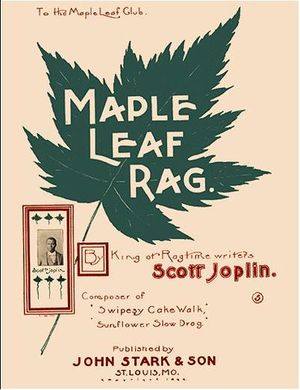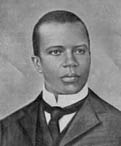| |
Ragtime
Music Sound
Ragtime
 Second edition cover of "Maple Leaf Rag", perhaps the most famous rag of
all
Second edition cover of "Maple Leaf Rag", perhaps the most famous rag of
all
Ragtime is an
American musical genre, enjoying its peak popularity around the years 1900–1918.
Ragtime is a dance form written in 2/4 or 4/4 time, with bass notes played on
the odd-numbered beats and chords played on the even-numbered beats. Many
ragtime pieces contain four distinct themes. Ragtime music is syncopated, with rhythmic accents on the weak beats.
The
etymology of the word ragtime is not known with certainty. Many
believe the origination to be from the words "ragged time" referencing the
characteristic syncopations which "tear up" the then normal accentuations of
previous popular music. Another theory suggests these words to be associated
with the walking bass set against the melodic line.
Historical context
Ragtime originated in
African American musical communities, in the late 19th century, and descended
from the jigs and marches played by all-black bands common in all Northern
cities with black populations (van der Merwe 1989, p.63). By the start of the
20th century it became widely popular throughout North America and was listened and danced to, performed, and written by people of
many different subcultures. A distinctly American musical style, ragtime may be
considered a synthesis of African-American syncopation and European classical
music, though this description is oversimplified.
Some early piano rags are entitled marches, and "jig" and "rag" were used
interchangeably in the mid 1890s (ibid.) and ragtime was also preceded by its
close relative the
Cakewalk. However, the emergence of mature ragtime is usually dated to 1897, the
year in which several important early rags were published. In 1899 Scott
Joplin's Maple Leaf Rag was published, which became a great hit and demonstrated
more depth and sophistication than earlier ragtime. Ragtime was one of the main
influences on the early development of jazz (along with the blues). Some
artists, like Jelly Roll Morton, were present and performed both ragtime and
jazz styles during the period the two genres overlapped. Jazz largely surpassed
ragtime in mainstream popularity in the early 1920s, although ragtime
compositions continue to be written up to the present, and periodic revivals of
popular interest in ragtime occurred in the 1950s and the 1970s.
Some authorities consider ragtime to be a form of
classical music. The heyday of ragtime predated the widespread availability
of
sound recording. Like classical music, and unlike jazz, classical ragtime
was and is primarily a written tradition, being distributed in
sheet
music rather than through recordings or by imitation of live performances.
Ragtime music was also distributed via piano rolls for player pianos. A folk
ragtime tradition also existed before and during the period of classical ragtime
(a designation largely created by Scott Joplin's publisher John Stark), manifesting itself mostly through string bands, banjo and
mandolin clubs (which experienced a burst of popularity during the early 20th
Century), and the like.
A form known as novelty piano (or novelty ragtime) emerged as the traditional
rag was fading in popularity. Where traditional ragtime depended on amateur
pianists and sheet music sales, the novelty rag took advantage of new advances
in piano-roll technology and the phonograph record to permit a more complex,
pyrotechnic, performance-oriented style of rag to be heard. Chief among the
novelty rag composers is Zez Confrey, whose "Kitten on the Keys" popularized the style in 1921.
Ragtime also served as the roots for
stride
piano, a more improvisational piano style popular in the 1920s and 1930s.
Elements of ragtime found their way into much of the American popular music of
the early 20th century.
Although most ragtime was composed for
piano,
transcriptions for other instruments and ensembles are common, notably including
Gunther Schuller's arrangements of Joplin's rags. Occasionally ragtime was
originally scored for ensembles (particlularly dance bands and
brass bands),
or as songs. Joplin had long-standing ambitions for a synthesis of the worlds of
ragtime and opera,
to which end the ragtime opera
Treemonisha was written; it is still performed today. An earlier opera
by Joplin, A Guest of Honor, has been lost.
Styles of ragtime
Ragtime pieces came in a number of different styles during the years of its
popularity and appeared under a number of different descriptive names. It is
related to several earlier styles of music, has close ties with later styles of
music, and was associated with a few musical "fads" of the period such as the
foxtrot. Many
of the terms associated with ragtime have inexact definitions, and are defined
differently by different experts; the definitions are muddled further by the
fact that publishers often labelled pieces for the fad of the moment rather than
the true style of the composition. There is even disagreement about the term
"ragtime" itself; experts such as David Jasen and Trebor Tichenor choose to
exclude ragtime songs from the definition but include novelty piano and stride
piano (a modern perspective), while Edward A. Berlin includes ragtime songs and
excludes the later styles (which is closer to how ragtime was viewed
originally). Many ragtime pianists, Eubie Blake and Mark Birnbaum among them,
include the songs and the later styles as ragtime. The terms below should not be
considered exact, but merely an attempt to pin down the general meaning of the
concept.
- Cakewalk - A pre-ragtime dance form popular until about 1904. The
music is intended to be representative of an African-American dance contest
in which the prize is a cake. Many early rags are cakewalks.
-
Characteristic March - A pre-ragtime dance form popular until about
1908. A march incorporating idiomatic touches (such as syncopation)
supposedly characteristic of the race of their subject, which is usually
African-Americans. Many early rags are characteristic marches.
- Two-Step - A pre-ragtime dance form popular until about 1911. A
large number of rags are two-steps.
- Slow Drag - Another dance form associated with early ragtime. A
modest number of rags are slow drags.
-
Coon Song - A pre-ragtime vocal form popular until about 1901. A
song with crude, racist lyrics often sung by white performers in blackface.
Gradually died out in favor of the ragtime song. Strongly associated with
ragtime in its day, it is one of the things that gave ragtime a bad name.
-
Ragtime Song - The vocal form of ragtime, more generic in theme than
the coon song. Though this was the form of music most commonly considered
"ragtime" in its day, many people today prefer to put it in the "popular
music" category.
Irving Berlin was a famous composer and Gene Greene was a famous singer in this style.
-
Folk Rag - A name often used to describe ragtime that originated
from small towns or assembled from folk strains, or at least sounded as if
they did. Folk rags often have unusual chromatic features typical of
composers with non-standard training.
-
Classic Rag - A name used to describe the Missouri-style ragtime
popularized by Scott Joplin, Tom Turpin, and others.
- Fox-Trot - A dance fad which began in 1913. Fox-trots contain a
dotted-note rhythm different from that of ragtime, but which nonetheless was
incorporated into many late rags.
-
Novelty Piano - A piano composition emphasizing speed and complexity
which emerged after World War I. It is almost exclusively the domain of
white composers.
- Stride
Piano - A style of piano which emerged after World War I, developed
by and dominated by black East coast pianists
(James P. Johnson, Fats Waller and Willie 'The Lion' Smith). Together with
novelty piano, it may be considered a successor to ragtime, but is not
considered by all to be "genuine" ragtime.
Ragtime revivals
In the early 1940s
many jazz bands
began to include ragtime in their repertoire and put out ragtime recordings on
78 RPM records. Old numbers written for piano were rescored for jazz instruments
by jazz musicians, which gave the old style a new sound. The most famous
recording of this period is Pee Wee Hunt's version of Euday L. Bowman's Twelfth Street Rag.
A more significant revival occurred in the
1950s. A wider
variety of ragtime styles of the past were made available on records, and new
rags were composed, published, and recorded. Much of the ragtime recorded in
this period is presented in a light-hearted novelty style, looked to with
nostalgia as the product of a supposedly more innocent time. A number of popular
recordings featured "prepared pianos," playing rags on pianos with tacks on the
keys and the instrument deliberately somewhat out of tune, supposedly to
simulate the sound of a piano in an old
honky tonk.
Three events brought forward a different kind of ragtime revival in the
1970s. First, pianist Joshua Rifkin brought out a compilation of Scott Joplin's
work on Nonesuch records, winning a Grammy in the classical music category. This
reintroduced Joplin's music to the public in the manner the composer had
intended, not as a nostalgic stereotype but as serious, respectable music.
Second, the New York Public Library released a two-volume set of "The Collected
Works of Scott Joplin," which renewed interest in Joplin among musicians and
prompted new stagings of Joplin's opera Treemonisha. Finally, with the release
of the motion picture The Sting in 1974, which had a Marvin Hamlisch soundtrack of Joplin tunes, ragtime was brought to a wide
audience. Hamlisch's rendering of Joplin's 1902 rag The Entertainer was a
top 40 hit in 1974.
Ragtime composers
 Scott Joplin
Scott Joplin
The most famous ragtime composer was Scott Joplin. Joseph Lamb and James
Scott are, together with Joplin, acknowledged as the three most sophisticated
ragtime composers. Some rank Artie Matthews as belonging with this distinguished
company. Other notable ragtime composers included May Aufderheide, Eubie Blake,
George Botsford, Zez Confrey, Ben Harney, Charles L. Johnson, Luckey Roberts,
Paul Sarebresole, Wilber Sweatman, and Tom Turpin. Modern ragtime composers
include William Bolcom, David Thomas Roberts, Frank French, Trebor Tichenor,
Mark Birnbaum and Reginald R. Robinson.
Samples
-
Download recording — "The Wagon" ragtime from
the Library of Congress' Gordon Collection; an early ragtime song sung by
Ben Harney in Philadelphia, Pennsylvania on about September 9, 1925
Sources
- van der Merwe, P. (1989).
Origins of the popular style: the antecedents of twentieth-century
popular music. Oxford: Clarendon Press.
ISBN 0193161214.
Further reading
- Berlin, E.A. (1980).
Ragtime: a musical and cultural history. University of California Press.
- Blesh, R., and Janis, H.
(1971). They all played ragtime, 4th ed.. Oak Publications.
- Jasen, D.A., and Tichenor,
T.J. (1980). Rags and ragtime. Dover.
- Schafer, W.J., and Riedel,
J. (1973). The art of ragtime: form and meaning of an original black
American art. Louisiana State University Press.
External links
Home | Up | Album | Aleatoric music | Anthem | Ballet | Cantata | Choir | Compositions by instrument | Concert band | Concerto | Film score | Incidental music | Jazz | Mass | Minimalist music | Opera | Operetta | Oratorio | Overture | Pieces | Ragtime | Recorded music | Serialism | Sonata | Song | Suite | Symphonic poem | Symphony | Television news music | Twelve tone technique | Fanfare | International Standard Musical Work Code | Lyrics | Precompositional | Round
Music Sound, v. 2.0, by MultiMedia
This guide is licensed under the GNU
Free Documentation License. It uses material from the Wikipedia.
|
|







